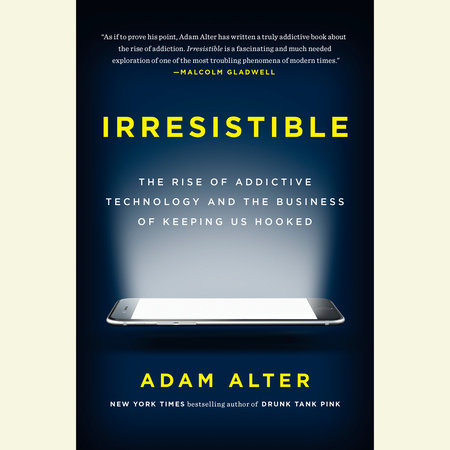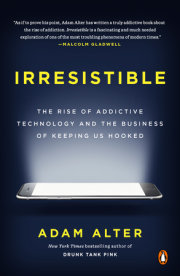“As if to prove his point, Adam Alter has written a truly addictive book about the rise of addiction. Irresistible is a fascinating and much needed exploration of one of the most troubling phenomena of modern times.” —Malcolm Gladwell, author of New York Times bestsellers David and Goliath and Outliers
“Alter’s sweep is broad: He includes not just the more obvious addictive technologies such as slot machines and video games, but the whole sweep of social media, dating apps, online shopping and other binge-inducing programs. He takes in everything (which today is most things) whose business model depends on being irresistible . . . [An] enjoyable yet alarming book.” —Washington Post
“If you can't stop checking, clicking, surfing and liking, put your device down and read Adam Alter's Irresistible, an important, groundbreaking book about why we're addicted to technology, how we got here, and what we should do next.” —Arianna Huffington, author of The Sleep Revolution and Thrive
“One of the most mesmerizing and important books I’ve read in quite some time. Alter brilliantly illuminates the new obsessions that are controlling our lives and offers the tools we need to rescue our businesses, our families, and our sanity.” —Adam Grant, New York Times bestselling author of Originals and Give and Take
“This important book explores how technology keeps us hooked, why that’s destructive—and how to take back control.” —People
“In this smart, sharply-argued book, Adam Alter lays out the evidence for a hidden danger in our lives: behavioral addiction. From tracking social media “likes” to counting our steps, our actions are being guided less by our own volition than by the architecture of the technologies we use. Irresistible is a fascinating read that will leave you enlightened—and alarmed.” —Daniel H. Pink, author of To Sell Is Human and Drive
“For many, social media presents an ideal mode of expression, but it also holds the danger of becoming a crutch or—as Adam Alter’s brilliant new book illustrates—a behavioral addiction that threatens to undermine our mental health and relationships. Irresistible offers a crucial understanding of how we are psychologically tethered to our devices, along with much-needed solutions so that we can live rich, meaningful and healthy lives in an increasingly tech-driven age.” —Susan Cain, co-founder of Quiet Revolution and New York Times bestselling author of Quiet: The Power of Introverts in a World That Can’t Stop Talking
“Adam Alter has achieved the Holy Grail: a book that’s important, insightful, and a pleasure to read. With cutting-edge research about our tech-obsessed world, he soothes us via novel solutions to wean us from our social networks, smartphones, games, fitness watches and other gadgets. He also illustrates the stakes: that these technologies are preventing us from forming meaningful relationships, raising empathetic children , and separating work from sleep and play. Irresistible is essential reading if you’ve ever wondered why some experiences are so addictive, and how to regain control of your time, finances, and relationships.” —Charles Duhigg, author of New York Times bestseller The Power of Habit
“In Irresistible, Adam Alter illuminates the surprising, fascinating, and frightening biological and psychological connections between a toddler hitting every button in an elevator, a surgical patient asking for painkillers, and the millions of people hooked on Facebook. No one who has ever seen an advertisement, checked their email on a smartphone, or used the Internet will come away quite the same.” —David Epstein, author of New York Times bestseller The Sports Gene
“I originally wrote this sentence on an analog word processor—that is, paper. Such was the impact of Adam Alter's meticulous research into behavioral addiction that I've become increasingly frightened of the monster that is my computer. Alter isn't an alarmist, and is evenhanded and rational in his approach toward technology, which makes his fascinating and witty book all the more powerful. In a world of ever-increasing connectivity and omnipresent screens, Irresistible is absolutely essential reading. But for your own sake, buy the paper version.” —Maria Konnikova, author of The Confidence Game and Mastermind
“There could be no better guide than Adam Alter to a technological landscape that’s increasingly designed to turn us into addicts. Irresistible is both a brilliant exploration of the sometimes sinister ways we get hooked, and a manual for finding focus and human connection in the midst of it all. Your sanity will thank you for reading it.” —Oliver Burkeman, author of The Antidote: Happiness for People Who Can't Stand Positive Thinking
“Looked at your phone recently? I thought so. Our devices have become more addictive than any drug, and thanks to Irresistible, now we know why. A powerful look at how technology sucks us in, and what we can do to resist its pull.” —Jonah Berger, author of New York Times bestseller Contagious
“We live in an age of addiction—seemingly benign and otherwise—and Adam Alter, mixing the latest in behavioral science with briskly engaging storytelling, wakes us to an age-old problem that has found troubling new expression in the era of ubiquitous technology. You may never look at your smartphone in the same way again.” —Tom Vanderbilt, author of Traffic and You May Also Like
“Adam Alter’s brilliant book is a necessary map for navigating a digitally connected world that’s teeming with addictive temptations. It's also a crackerjack box of fascinating scientific discoveries on games, habits, and behaviors. I circled, starred, underlined, or wrote exclamation marks on basically every page.” —Derek Thompson, Senior Editor at The Atlantic, and author of Hit Makers
“A provocative, clearly written book that argues new technology causes new addictions.” —Kevin Ashton, author of How to Fly a Horse
“[A] superb study of Internet addiction.” —Nature
“A book [that] lives up to its title.” —New Scientist
“Contains smart and fascinating analysis of how social media apps, gambling sites and computer games have been engineered to hook users.” —New Statesman (UK)
“Adam Alter makes the frightening case that . . . modern connectivity threatens the health of not just our children, but everyone . . . Alter’s book is illuminating on the ways that designers engineer behavioural addiction . . . Fascinating.” —The Guardian
“With a background in psychology and marketing, Alter brings a specialist eye to his material, and it shows . . . A fascinating, salutary read . . . Compelling.” —The Daily Telegraph (UK)
“Digs down into exactly how technology has us hooked by tapping in to our deepest needs and desires . . . Irresistible brims with insightful studies, explaining arcane concepts in science and tech with great clarity.” —The Times (UK)










